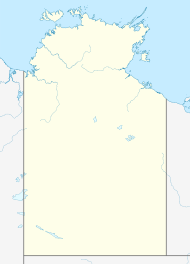Bulman, Northern Territory facts for kids
Quick facts for kids BulmanNorthern Territory |
|
|---|---|
| Population | 291 (2011 census) |
| Postcode(s) | 0852 |
| Location | |
| LGA(s) | Roper Gulf Region |
| Territory electorate(s) | Arnhem |
| Federal Division(s) | Lingiari |
Bulman is a small town in the Northern Territory of Australia. It is about 400 kilometers (250 miles) by air from Darwin.
Bulman is very close to another Aboriginal community called Weemol, which is only 5 kilometers (3 miles) away. Together, Bulman and Weemol are considered a closed community. This means that visitors need a special permit from the Northern Land Council to enter or travel through the town.
In 2011, the total population of Bulman and Weemol was 291 people. Bulman is one of the few important towns along the Central Arnhem Road. This road connects Katherine and Nhulunbuy.
The town has important services for its residents. These include a school, a health clinic, and a police station. There is also an airstrip that can be used in all types of weather. People in Bulman speak different languages, such as Kriol, English, and Rembarrnga.
Bulman is very isolated. During the wet season, it can be completely cut off from other areas. For example, in 2010, after Tropical Cyclone Paul, the town received 443 millimeters (about 17 inches) of rain in just one day. This heavy rain closed all roads and the airport.
Contents
Famous People from Bulman
Chris Hemsworth's Childhood
Did you know that famous actor Chris Hemsworth lived in Bulman? He was born in Melbourne, Victoria, Australia. But he spent some of his early years in Bulman.
Chris Hemsworth remembers his time there well. He said, "My earliest memories were on the cattle stations up in the Outback." He also mentioned that his most vivid memories were from Bulman. He recalled seeing "crocodiles and buffalo." He described it as a "very different walk of life" compared to Melbourne.
Bulman's Weather
Understanding the Climate
Bulman has a tropical climate. This means it usually has hot temperatures and a distinct wet and dry season. The wet season brings a lot of rain, as mentioned earlier.
| Climate data for Bulman (2002–2024) | |||||||||||||
|---|---|---|---|---|---|---|---|---|---|---|---|---|---|
| Month | Jan | Feb | Mar | Apr | May | Jun | Jul | Aug | Sep | Oct | Nov | Dec | Year |
| Record high °C (°F) | 40.8 (105.4) |
40.8 (105.4) |
41.5 (106.7) |
39.6 (103.3) |
36.7 (98.1) |
36.1 (97.0) |
37.0 (98.6) |
37.6 (99.7) |
41.0 (105.8) |
44.0 (111.2) |
42.9 (109.2) |
43.6 (110.5) |
44.0 (111.2) |
| Mean daily maximum °C (°F) | 35.1 (95.2) |
34.8 (94.6) |
34.7 (94.5) |
34.3 (93.7) |
32.6 (90.7) |
30.6 (87.1) |
31.1 (88.0) |
32.9 (91.2) |
36.2 (97.2) |
38.4 (101.1) |
38.8 (101.8) |
37.3 (99.1) |
34.7 (94.5) |
| Mean daily minimum °C (°F) | 24.5 (76.1) |
24.1 (75.4) |
23.5 (74.3) |
21.0 (69.8) |
18.5 (65.3) |
15.3 (59.5) |
14.2 (57.6) |
14.6 (58.3) |
18.2 (64.8) |
22.0 (71.6) |
24.4 (75.9) |
24.8 (76.6) |
20.4 (68.7) |
| Record low °C (°F) | 19.3 (66.7) |
16.9 (62.4) |
15.9 (60.6) |
11.8 (53.2) |
8.9 (48.0) |
3.6 (38.5) |
4.4 (39.9) |
6.0 (42.8) |
7.5 (45.5) |
12.4 (54.3) |
16.4 (61.5) |
18.9 (66.0) |
3.6 (38.5) |
| Average rainfall mm (inches) | 236.9 (9.33) |
220.1 (8.67) |
223.3 (8.79) |
60.1 (2.37) |
14.6 (0.57) |
1.2 (0.05) |
1.0 (0.04) |
0.7 (0.03) |
12.8 (0.50) |
19.0 (0.75) |
60.1 (2.37) |
192.7 (7.59) |
1,042 (41.02) |
| Average rainy days (≥ 1.0 mm) | 15 | 12.9 | 11.5 | 4.9 | 1.7 | 0.1 | 0.2 | 0.2 | 0.2 | 1.5 | 4.6 | 10.8 | 63.6 |
| Source: Australian Bureau of Meteorology | |||||||||||||
See also

- In Spanish: Bulman para niños


